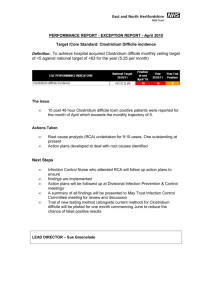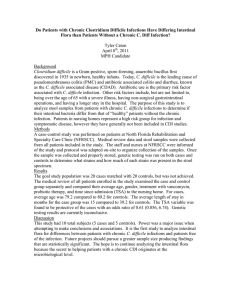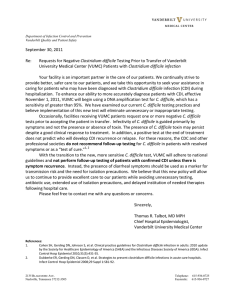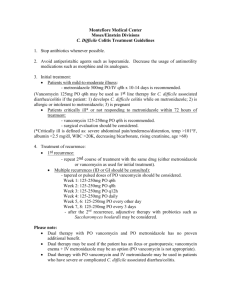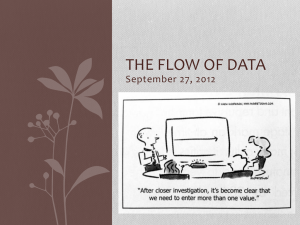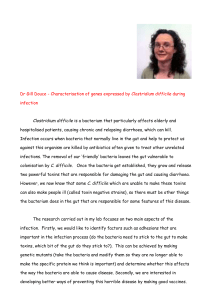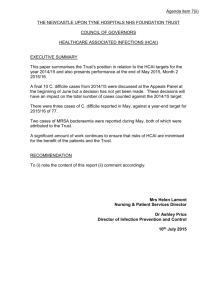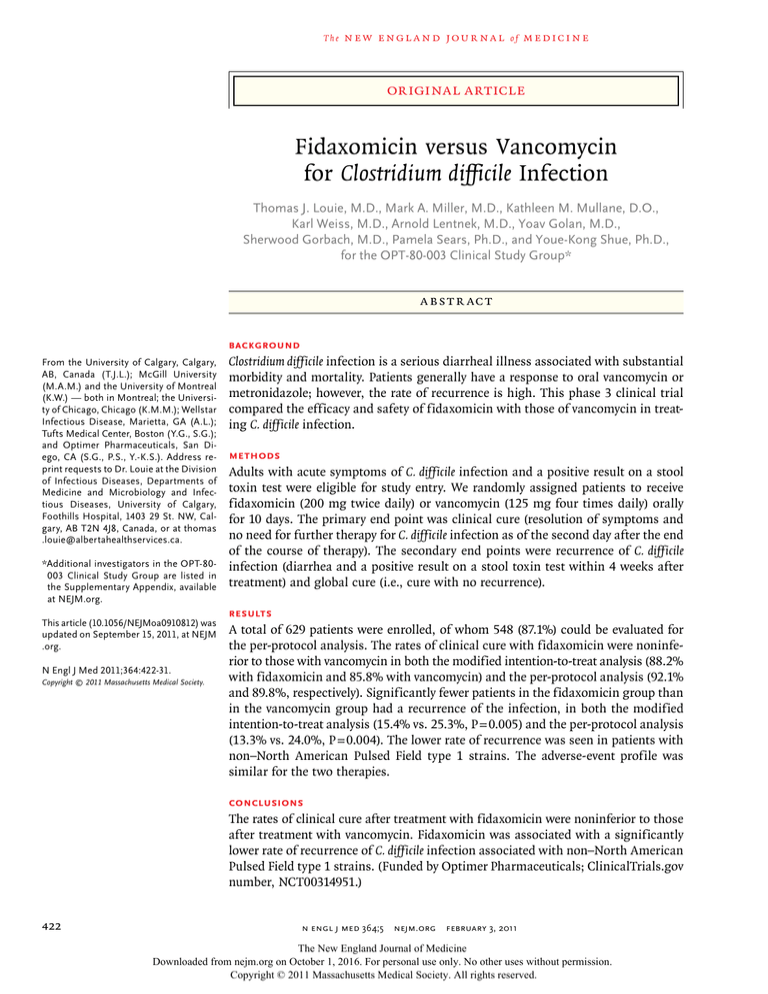
The
n e w e ng l a n d j o u r na l
of
m e dic i n e
original article
Fidaxomicin versus Vancomycin
for Clostridium difficile Infection
Thomas J. Louie, M.D., Mark A. Miller, M.D., Kathleen M. Mullane, D.O.,
Karl Weiss, M.D., Arnold Lentnek, M.D., Yoav Golan, M.D.,
Sherwood Gorbach, M.D., Pamela Sears, Ph.D., and Youe-Kong Shue, Ph.D.,
for the OPT-80-003 Clinical Study Group*
A bs t r ac t
Background
From the University of Calgary, Calgary,
AB, Canada (T.J.L.); McGill University
(M.A.M.) and the University of Montreal
(K.W.) — both in Montreal; the University of Chicago, Chicago (K.M.M.); Wellstar
Infectious Disease, Marietta, GA (A.L.);
Tufts Medical Center, Boston (Y.G., S.G.);
and Optimer Pharmaceuticals, San Diego, CA (S.G., P.S., Y.-K.S.). Address reprint requests to Dr. Louie at the Division
of Infectious Diseases, Departments of
Medicine and Microbiology and Infectious Diseases, University of Calgary,
Foothills Hospital, 1403 29 St. NW, Calgary, AB T2N 4J8, Canada, or at thomas
.louie@albertahealthservices.ca.
*Additional investigators in the OPT-80003 Clinical Study Group are listed in
the Supplementary Appendix, available
at NEJM.org.
This article (10.1056/NEJMoa0910812) was
updated on September 15, 2011, at NEJM
.org.
N Engl J Med 2011;364:422-31.
Copyright © 2011 Massachusetts Medical Society.
Clostridium difficile infection is a serious diarrheal illness associated with substantial
morbidity and mortality. Patients generally have a response to oral vancomycin or
metronidazole; however, the rate of recurrence is high. This phase 3 clinical trial
compared the efficacy and safety of fidaxomicin with those of vancomycin in treating C. difficile infection.
Methods
Adults with acute symptoms of C. difficile infection and a positive result on a stool
toxin test were eligible for study entry. We randomly assigned patients to receive
fidaxomicin (200 mg twice daily) or vancomycin (125 mg four times daily) orally
for 10 days. The primary end point was clinical cure (resolution of symptoms and
no need for further therapy for C. difficile infection as of the second day after the end
of the course of therapy). The secondary end points were recurrence of C. difficile
infection (diarrhea and a positive result on a stool toxin test within 4 weeks after
treatment) and global cure (i.e., cure with no recurrence).
Results
A total of 629 patients were enrolled, of whom 548 (87.1%) could be evaluated for
the per-protocol analysis. The rates of clinical cure with fidaxomicin were noninferior to those with vancomycin in both the modified intention-to-treat analysis (88.2%
with fidaxomicin and 85.8% with vancomycin) and the per-protocol analysis (92.1%
and 89.8%, respectively). Significantly fewer patients in the fidaxomicin group than
in the vancomycin group had a recurrence of the infection, in both the modified
intention-to-treat analysis (15.4% vs. 25.3%, P = 0.005) and the per-protocol analysis
(13.3% vs. 24.0%, P = 0.004). The lower rate of recurrence was seen in patients with
non–North American Pulsed Field type 1 strains. The adverse-event profile was
similar for the two therapies.
Conclusions
The rates of clinical cure after treatment with fidaxomicin were noninferior to those
after treatment with vancomycin. Fidaxomicin was associated with a significantly
lower rate of recurrence of C. difficile infection associated with non–North American
Pulsed Field type 1 strains. (Funded by Optimer Pharmaceuticals; ClinicalTrials.gov
number, NCT00314951.)
422
n engl j med 364;5 nejm.org february 3, 2011
The New England Journal of Medicine
Downloaded from nejm.org on October 1, 2016. For personal use only. No other uses without permission.
Copyright © 2011 Massachusetts Medical Society. All rights reserved.
Fidaxomicin vs. Vancomycin for C. difficile Infection
C
lostridium difficile infection generally occurs after exposure to broad-spectrum
antibiotics. The incidence and severity of
C. difficile infection are increasing. The increases
have been ascribed to the emergence of a hypervirulent C. difficile strain, known variously as North
American Pulsed Field type 1 (NAP1), restrictionendonuclease analysis (REA) type BI, or polymerase-chain-reaction ribotype 027 (referred to
collectively as the NAP1/BI/027 strain).1-4 Furthermore, the rates of death associated with C. difficile
infection are rising,5-7 and the infection is occurring in populations that were previously considered to be at low risk, such as young, healthy persons living in the community and peripartum
women.8,9 As compared with observations in the
mid-1990s,10 the reduced rates of clinical response
and increased recurrence rates seen in more recent studies are cause for concern.11-14
Fidaxomicin (previously referred to as OPT-80),
a macrocyclic antibiotic, is more active in vitro
than vancomycin, by a factor of approximately 8,
against clinical isolates of C. difficile, including
NAP1/BI/027 strains.15-19 This activity, in combination with minimal systemic absorption,20 high
fecal concentrations, and limited activity in vitro15‑19 and in vivo21 against components of the
normal gut flora, makes fidaxomicin a promising candidate that may provide highly active but
more selective therapy for C. difficile infection. In
a dose-finding, randomized, open-label, phase 2
trial, treatment with fidaxomicin was associated
with a good clinical response and a low rate of
recurrence.22 The results of a phase 3 noninferiority study comparing fidaxomicin with vancomycin in 629 patients with C. difficile infection are
reported here.
Me thods
Study Design
This prospective, multicenter, double-blind, randomized, parallel-group trial was conducted between May 9, 2006, and August 21, 2008, in
accordance with the ethical principles of the
Declaration of Helsinki and the principles of current Good Clinical Practices. The study protocol
and amendments were approved by local or central institutional review boards. All patients provided written informed consent. Optimer Pharmaceuticals sponsored the study. The data were
monitored and retrieved by INC Research (a contract research organization). The analysis of the
data was performed by all the authors, along with
an additional investigator at Optimer Pharmaceuticals. The first draft of the manuscript was
written by one of the authors who is a part-time
employee of Optimer Pharmaceuticals; that author along with the first two authors wrote subsequent drafts of the manuscript. All the authors, on behalf of the OPT-80-003 clinical trial
study group, made the decision to submit the manuscript for publication. The protocol, including
the statistical analysis plan, is available with the
full text of this article at NEJM.org. All the authors vouch for the accuracy and completeness of
the data presented and the fidelity of the reported study to the trial protocol.
Study Population
Patients were enrolled at 52 sites in the United
States and 15 sites in Canada. Eligible patients
were 16 years of age or older with a diagnosis of
C. difficile infection, defined by the presence of diarrhea (a change in bowel habits, with more than
three unformed bowel movements in the 24-hour
period before randomization) and C. difficile toxin
A, B, or both in a stool specimen obtained within
48 hours before randomization. Patients could
have received up to four doses of metronidazole
or vancomycin in the 24 hour-period before randomization and no other potentially effective concurrent treatments for C. difficile infection (e.g.,
oral bacitracin, fusidic acid, or rifaximin). Patients with life-threatening or fulminant C. difficile infection, toxic megacolon, previous exposure
to fidaxomicin, a history of ulcerative colitis or
Crohn’s disease, or more than one occurrence of
C. difficile infection within 3 months before the
start of the study were excluded.
Randomization and Treatment
After providing informed consent, patients were
stratified according to whether the current C. difficile infection was the first episode (primary occurrence) or second episode (first recurrence) within the 3 months before the start of the study. An
interactive voice-response system and computergenerated randomization schedule were used to
provide a randomization number and medicationkit number for each patient. Patients received the
study medication orally each day for 10 days, according to an every-6-hour regimen: 200 mg of
fidaxomicin every 12 hours with intervening
matching doses of placebo or 125 mg of vancomycin every 6 hours. The two study medications
n engl j med 364;5 nejm.org february 3, 2011
The New England Journal of Medicine
Downloaded from nejm.org on October 1, 2016. For personal use only. No other uses without permission.
Copyright © 2011 Massachusetts Medical Society. All rights reserved.
423
The
n e w e ng l a n d j o u r na l
and placebo were overencapsulated to look the
same. Patients were assessed daily for clinical cure
or failure during the 10-day course of therapy. If
the criteria for clinical cure were met, the patient
was followed for recurrence, by means of a weekly
assessment, for 28 days after the last dose of
study medication had been administered, with
immediate patient-initiated reassessment by the
study team if diarrhea recurred.
Definitions
Clinical cure was defined by the resolution of diarrhea (i.e., three or fewer unformed stools for
2 consecutive days), with maintenance of resolution for the duration of therapy and no further
requirement (in the investigator’s opinion) for
therapy for C. difficile infection as of the second day
after the end of the course of therapy. Patients
who had a marked reduction in the number of
unformed stools at the end of treatment but who
had residual mild abdominal discomfort were considered by the investigator to have met the criteria
for clinical cure, providing that no new anti-infective therapy for C. difficile infection was required.
Clinical failure was defined by the persistence of
diarrhea, the need for additional therapy for
C. difficile infection, or both, in the opinion of the
investigator. Global cure was defined as the resolution of diarrhea without recurrence.
Patients who remained in the study and had
a follow-up assessment between days 36 and 40
after randomization were evaluated for recurrence.
Clinical recurrence was defined by the reappearance of more than three diarrheal stools per 24hour period within 4 weeks after the cessation of
therapy; C. difficile toxin A or B, or both, in stool;
and a need for retreatment for C. difficile infection.
of
m e dic i n e
mented adherence to the protocol, and underwent
an end-of-therapy evaluation. The secondary efficacy end point was recurrence of C. difficile infection during the 4-week period after the end of
the course of therapy and global cure in the modified intention-to-treat and per-protocol populations.
Microbiologic Evaluation
Fecal samples for toxin assays to verify C. difficile
infection and microbiologic testing were obtained
at the time of screening or enrollment, at the time
of early termination or the end-of-therapy visit in
the case of patients with clinical failure, and at
visits for the diagnosis and treatment of recurrent infection in the case of patients in whom the
disease recurred. Toxin tests were performed at
individual study sites. Assays for C. difficile isolation and susceptibility were performed by R.M.
Alden Research Laboratory with the use of the
Clinical and Laboratory Standards Institute agar
dilution method (CLSI M11-A7). Restriction-endonuclease typing23,24 was performed at the Edward
Hines, Jr., Veterans Affairs Hospital.
Pharmacokinetic Evaluation
Blood samples for pharmacokinetic evaluation
were obtained before and 3 to 5 hours after the
first dose of the study medication on day 1 and at
the end-of-therapy or early-termination visit. Fecal samples were obtained at the end-of-therapy
or early-termination visit. Plasma concentrations
(Tandem Labs) and fecal concentrations (MicroConstants) of fidaxomicin were determined with
the use of reverse-phase, high-performance liquid
chromatography with tandem mass spectrometry.
Safety
Outcomes
Efficacy Evaluation
The primary efficacy end point was the rate of
clinical cure in the modified intention-to-treat and
per-protocol populations at the end of therapy or
at the time of early withdrawal from the study.
The modified intention-to-treat population comprised patients with documented C. difficile infection who underwent randomization and received
at least one dose of study medication. The perprotocol population comprised patients in the
modified intention-to-treat group who received
treatment for at least 3 days (in the case of patients with treatment failure) or at least 8 days (in
the case of patients with clinical cure), had docu424
Safety was assessed from the day informed consent was provided through the day the last dose
of the study drug was administered or the last
study visit occurred, whichever came later. The
assessment included a physical examination, electrocardiography (ERT), and clinical laboratory
testing, including hematologic and biochemical
tests and urinalysis (Covance). The safety population comprised patients who received at least one
dose of the study medication and underwent at
least one safety assessment after the first dose of
the study medication. Adverse events were classified according to the terms used in the Medical
Dictionary for Regulatory Activities. An adverse event
could be reported more than once for a patient,
n engl j med 364;5 nejm.org february 3, 2011
The New England Journal of Medicine
Downloaded from nejm.org on October 1, 2016. For personal use only. No other uses without permission.
Copyright © 2011 Massachusetts Medical Society. All rights reserved.
Fidaxomicin vs. Vancomycin for C. difficile Infection
but each patient was counted only once in the in- analysis (265 in the fidaxomicin group and 283
in the vancomycin group). Adherence to the study
cidence count for a particular adverse event.
medication was similar in the two treatment
Statistical Analysis
groups; in the modified intention-to-treat popuThe trial was designed as a noninferiority study. lation, 91.7% in the fidaxomicin group and 91.4%
A one-sided lower 97.5% confidence interval was in the vancomycin group took the assigned doses,
used in the analysis of the primary end point, the and in the per-protocol population, 95.8% and
rate of clinical cure, with a noninferiority margin 96.1% in the two groups, respectively, took the
of −10 percentage points. If the lower boundary of assigned doses. The safety population comprised
the confidence limit was within the 10-percentage- 623 patients — 300 in the fidaxomicin group
point margin, clinical noninferiority was demon- and 323 in the vancomycin group. The two treatstrated. The secondary end points of recurrence ment groups did not differ significantly with reand overall cure, which were prospectively de- spect to baseline characteristics (Table 1).
fined as descriptive end points, were analyzed by
means of post hoc hypothesis tests with the use Clinical Outcomes
of two-sided tests of population proportions that The overall outcomes are shown in Figure 2. The
were based on the normal approximation to the criterion for noninferiority with respect to the pribinomial distribution, at a significance level of mary end point of clinical cure was met in both
0.05. Treatment differences according to age, in- the modified intention-to-treat and per-protocol
patient versus outpatient status, prior occurrence populations. In the modified intention-to-treat
of C. difficile infection versus no prior occurrence, population, 88.2% of patients in the fidaxomicin
disease severity (mild disease, defined by the pres- group (253 of 287 patients) and 85.8% of those in
ence of 4 to 5 unformed bowel movements per day the vancomycin group (265 of 309) met the criteor a white-cell count of ≤12,000 per cubic milli- ria for clinical cure (with a lower boundary of the
meter; moderate disease, defined by the presence 97.5% confidence interval [CI] for the difference
of 6 to 9 unformed bowel movements per day or a in cure rates of −3.1 percentage points). In the
white-cell count of 12,001 to 15,000 per cubic mil- per-protocol population, 92.1% of the patients in
limeter; or severe disease, defined by the presence the fidaxomicin group (244 of 265 patients) and
of ≥10 unformed bowel movements per day or a 89.8% of the patients in the vancomycin group
white-cell count of ≥15,001 per cubic millimeter), (254 of 283) were considered to have met the criand strain type were also assessed by means of teria for clinical cure (with a lower boundary of
post hoc analyses. The time to resolution of diar- the 97.5% CI of −2.6 percentage points). Subgroup
rhea, defined as the interval, in hours, from the analyses of the rates of clinical cure according to
start of treatment until the time the last un- the patients’ age, inpatient versus outpatient staformed bowel movement occurred on the day be- tus, prior occurrence of C. difficile infection versus
fore resolution of diarrhea, was analyzed with the no prior occurrence, treatment for C. difficile inuse of the Kaplan–Meier method, with a Gehan– fection versus no treatment within 24 hours beWilcoxon test for comparison of resolution time fore the start of the study, baseline severity of the
curves. All summary statistics are presented as disease, infecting strain type, no response versus
means ±SD for continuous variables and as num- response to previous metronidazole therapy, and
use versus nonuse of concomitant systemic antibers and percentages for categorical variables.
microbial therapy showed no significant differences between treatments in both the modified
R e sult s
intention-to-treat and per-protocol populations
Patients
(Table 2).
A total of 629 patients were enrolled and underTreatment with fidaxomicin was associated
went randomization: 302 received fidaxomicin, with a significantly lower rate of recurrence than
and 327 received vancomycin. Figure 1 shows the was treatment with vancomycin in both the modirandomization and follow-up of patients in the fied intention-to-treat population (15.4% [39 of
study. A total of 596 patients were included in the 253 patients] vs. 25.3% [67 of 265]; a reduction
modified intention-to-treat analysis (287 in the with fidaxomicin of 9.9 percentage points; 95% CI,
fidaxomicin group and 309 in the vancomycin −16.6 to −2.9; P = 0.005) and the per-protocol
group) and 548 were included in the per-protocol population (13.3% [28 of 211 patients] vs. 24.0%
n engl j med 364;5 nejm.org february 3, 2011
The New England Journal of Medicine
Downloaded from nejm.org on October 1, 2016. For personal use only. No other uses without permission.
Copyright © 2011 Massachusetts Medical Society. All rights reserved.
425
The
n e w e ng l a n d j o u r na l
of
m e dic i n e
629 Patients were enrolled and underwent
randomization
327 Were assigned to receive vancomycin
302 Were assigned to receive fidaxomicin
4 Withdrew before treatment
6 Had ≤3 bowel motions in 24 hr
8 Tested negative for C. difficile toxin
2 Withdrew before treatment
4 Had ≤3 bowel motions in 24 hr
9 Tested negative for C. difficile toxin
309 (94.5%) Were included in modified
intention-to-treat analysis
14 Had <3 days treatment in the
case of failure
7Had <8 days treatment in the
case of cure
1 Had no end-of-therapy evaluation
2 Had concomitant therapy for
C. difficile infection
2 Had other protocol violation
44 Had clinical failure
265 Had clinical cure
and could be evaluated for recurrence
287 (95.0%) Were included in modified
intention-to-treat analysis
34 Had clinical failure
253 Had clinical cure
and could be evaluated for recurrence
283 (86.5%) Were included in the
per-protocol analysis
12 Had <3 days treatment in the
case of failure
5 Had <8 days treatment in the
case of cure
1 Had no end-of-therapy evaluation
2 Had concomitant therapy for
C. difficile infection
2 Had other protocol violation
265 (87.7%) Were included in the
per-protocol analysis
15 Had <25 days follow-up and no
recurrence, or >30 days follow-up
with recurrence
11 Had concomitant therapy for
C. difficile infection
7 Had other protocol violation
29 Had clinical failure
12 Had <25 days follow-up and no
recurrence, or >30 days follow-up
with recurrence
12 Had concomitant therapy for
C. difficile infection
9 Had other protocol violation
21 Had clinical failure
221 Had clinical cure and could
be evaluated for recurrence
211 Had clinical cure and could
be evaluated for recurrence
Figure 1. Randomization and Follow-up.
[53 of 221]; a reduction with fidaxomicin of 10.7
percentage points; 95% CI, −17.9 to −3.3; P = 0.004).
Fidaxomicin treatment was also associated with
lower rates of recurrence when the analysis was
performed according to subgroups in both the
modified intention-to-treat and per-protocol populations (Table 3). The rates of recurrence in the
fidaxomicin and vancomycin groups were similar among patients with the NAP1/BI/027 strain:
24.4% (11 of 45 patients) and 23.6% (13 of 55),
respectively (P = 0.93). Among patients with other
strains, however, the rate of recurrence was lower
with fidaxomicin: 7.8% (8 of 103 patients), versus 25.5% (27 of 106) with vancomycin (a reduc426
tion with fidaxomicin of 17.7 percentage points;
95% CI, −27.5 to −7.9; P <0.001). This represents
a 69% relative reduction in recurrences with
fidaxomicin as compared with vancomycin in
the subgroup of patients with non–NAP1/BI/027
strains. The relative risk of recurrence for patients
with a non–NAP1/BI/027 strain was approximately 3.3 times as high (95% CI, 1.6 to 6.9) among
patients receiving vancomycin as among patients
receiving fidaxomicin. At the time a recurrence
occurred, the same REA strain type as that in
the initial occurrence was recovered in 12 of 14
patients in the fidaxomicin group and in 27 of
33 patients in the vancomycin group.
n engl j med 364;5 nejm.org february 3, 2011
The New England Journal of Medicine
Downloaded from nejm.org on October 1, 2016. For personal use only. No other uses without permission.
Copyright © 2011 Massachusetts Medical Society. All rights reserved.
Fidaxomicin vs. Vancomycin for C. difficile Infection
Table 1. Demographic and Baseline Clinical Characteristics of the Patients in the Modified Intention-to-Treat
and Per-Protocol Populations.*
Characteristic
Age (yr)
Modified Intention-to-Treat Population
Per-Protocol Population
Fidaxomicin Vancomycin Total
(N = 287)
(N = 309) (N = 596)
Fidaxomicin Vancomycin Total
(N = 265)
(N = 283) (N=548)
60.3±16.9
Female sex (%)
Unformed stools per day (no.)
Inpatient (%)
Lack of response to metronidazole (%)
62.9±16.9 61.6±16.9
59.9±17.1
62.7±17.0 61.3±17.1
57.1
54.7
55.9
57.4
54.8
56.0
8.1±4.2
8.3±5.4
8.2±4.8
8.2±4.3
8.4±5.5
8.3±4.9
58.2
60.5
59.4
55.1
57.2
56.2
4.5
5.5
5.0
4.9
5.7
5.3
Treatment for C. difficile infection
in previous 24 hr (%)
38.3
39.8
39.1
37.4
38.5
38.0
Previous episode of C. difficile
infection (%)
16.7
17.5
17.1
16.2
17.0
16.6
BI/NAP1/027 strain (%)†
37.5
38.6
38.1
35.3
36.4
35.9
*Plus–minus values are means ±SD. There were no significant between-group differences.
†Percentages are based on the 415 patients who had a strain type that could be evaluated.
Treatment with fidaxomicin resulted in significantly higher rates of resolution of diarrhea
without recurrence than did treatment with vancomycin: 74.6% (214 of 287 patients) versus 64.1%
(198 of 309) in the modified intention-to-treat
population (an increase with fidaxomicin of 10.5
percentage points; 95% CI, 3.1 to 17.7; P = 0.006)
and 77.7% (206 of 265 patients) versus 67.1% (190
of 283) in the per-protocol population (an increase
with fidaxomicin of 10.6 percentage points; 95%
CI, 3.1 to 17.9; P = 0.006).
The median time to resolution of diarrhea was
shorter in the fidaxomicin group than in the vancomycin group (58 hours vs. 78 hours in the
modified intention-to-treat population and 55
hours vs. 69 hours in the per-protocol population)
among both inpatients (91 hours vs. 120 hours
and 72 hours vs. 78 hours in the two populations,
respectively) and outpatients (47 hours vs. 61 hours
and 47 hours vs. 60 hours in the two populations,
respectively). None of these differences were significant.
Safety
60.4% of the patients in the vancomycin group;
the occurrence of any serious adverse event was
reported in 25.0% and 24.1% of the patients in
the two groups, respectively. Adverse events possibly or definitely related to the study treatment
were mild gastrointestinal and nonspecific symptoms; the rate of these events was similar in the
two groups (9.7% and 9.0% in the fidaxomicin and
vancomycin groups, respectively). Significantly
more serious adverse events related to laboratory
test results occurred in the fidaxomicin group
than in the vancomycin group (4.7% vs. 1.2%,
P = 0.01), without an obvious pattern (Table 2 in
the Supplementary Appendix). No subjects discontinued the study as a result of intolerance or allergy to the study medications.
Microbiologic Evaluation
Measurement of in vitro antimicrobial activity
against C. difficile showed minimum inhibitory
concentrations at or below 0.25 μg per milliliter
for 90% of isolates in the case of fidaxomicin
and 2.0 μg per milliliter in the case of vancomycin. There was no relationship between the minimum inhibitory concentration of baseline clinical isolates and the clinical outcome (cure or
recurrence). No shifts in susceptibility to fidaxomicin or vancomycin occurred during the study.
There were no significant differences between
the fidaxomicin group and the vancomycin group
in the rates of adverse events or serious adverse
events (see Tables 1 and 2 in the Supplementary
Appendix, available at NEJM.org). The occurrence
of any adverse event during the treatment period Pharmacokinetic Evaluation
until 7 days after treatment was reported in 62.3% The mean (±SD) plasma level of fidaxomicin afof the patients in the fidaxomicin group and ter administration of the drug on day 1 was
n engl j med 364;5 nejm.org february 3, 2011
The New England Journal of Medicine
Downloaded from nejm.org on October 1, 2016. For personal use only. No other uses without permission.
Copyright © 2011 Massachusetts Medical Society. All rights reserved.
427
The
n e w e ng l a n d j o u r na l
Fidaxomicin
of
m e dic i n e
Vancomycin
100
90
88.2
92.1
85.8
89.8
P=0.006
80
Patients (%)
77.7
74.6
70
P=0.006
67.1
64.1
60
50
40
P=0.005
30
P=0.004
25.3
20
15.4
24.0
13.3
10
0
mITT
PP
mITT
Clinical Cure
PP
Recurrence
mITT
PP
Global Cure
Figure 2. Rates of Primary and Secondary End Points.
For the primary outcome of clinical cure, the lower boundary of the 97.5% confidence interval for the difference in
cure rates between fidaxomicin and vancomycin was −3.1 percentage points in the modified intention-to-treat (mITT)
analysis and −2.6 percentage points in the per-protocol (PP) analysis.
22.8±26.5 ng per milliliter (range, 0.4 to 185.0).
In addition, no plasma accumulation was found
between day 1 and the end of therapy. The mean
end-of-therapy fecal concentration of fidaxomicin
was 1225.1±759.0 μg per gram (range, 31.7 to
4640.0), which is 4900 times as high as the minimum inhibitory concentration of 0.25 μg per
milliliter for 90% of isolates against C. difficile.
Discussion
During the past decade, the clinical profile of
C. difficile infection has worsened, with increased
numbers of cases, greater morbidity, an increased
incidence of complications requiring colectomy,
and rising mortality. These worsening disease
markers have occurred in parallel with the emergence of the new and more virulent BI/NAP1/027
C. difficile strain, although efforts to link a poor
outcome of infection to the hypervirulent strain
have not been uniformly successful.4,25-29 Regardless of the cause, C. difficile infection has become
a more serious disease in North America and Europe, even in countries with a relatively low incidence of the BI/NAP1/027 strain.
The initial therapeutic approach to a diagnosed
case of C. difficile infection is to discontinue the
antibiotic that precipitated the infection. Although
a minority of cases will resolve with cessation of
428
antibiotic selection pressure, the risk of worsening disease mandates that treatment be directed
against the pathogen. The standard treatments are
metronidazole and vancomycin. Both drugs have
liabilities. Metronidazole is efficiently absorbed,
so that only small quantities reach the colon,30
which is a pharmacodynamic disadvantage in a
primarily mucosal or luminal infection. In addition, it has systemic side effects, such as nausea,
headache, taste perversion, and peripheral neuropathy. Furthermore, several studies have shown
that metronidazole therapy, as compared with vancomycin therapy, is associated with more failures
and higher rates of recurrence, especially among
severely ill patients.31,32 Concern has been expressed that oral administration of metronidazole or vancomycin may induce the emergence of
vancomycin-resistant enterococci.33
One of the most problematic aspects of C. difficile infection is the rate of recurrence. After successful initial treatment with metronidazole or
vancomycin, 20 to 30% of patients have a recrudescence of illness within 60 days — but usually within the first 2 weeks.34 Retreatment with
metronidazole or vancomycin resolves the condition in most patients, but approximately one third
(or more) of patients have one or more additional
recurrences. Severe illness and deaths associated
with relapses have been reported at approximately
n engl j med 364;5 nejm.org february 3, 2011
The New England Journal of Medicine
Downloaded from nejm.org on October 1, 2016. For personal use only. No other uses without permission.
Copyright © 2011 Massachusetts Medical Society. All rights reserved.
Fidaxomicin vs. Vancomycin for C. difficile Infection
Table 2. Rates of Clinical Cure at the End of Therapy, According to Subgroups, in the Modified Intention-to-Treat and Per-Protocol
Populations.*
Subgroup
Modified Intention-to-Treat Population
Fidaxomicin
Vancomycin
Per-Protocol Population
Fidaxomicin
Vancomycin
number/total number (percent)
Age
<65 yr
150/165 (90.9)
134/157 (85.4)
145/152 (95.4)
132/145 (91.0)
≥65 yr
103/122 (84.4)
131/152 (86.2)
99/113 (87.6)
122/138 (88.4)
Inpatient
136/167 (81.4)
146/187 (78.1)
128/146 (87.7)
136/162 (84.0)
Outpatient
117/120 (97.5)
119/122 (97.5)
116/119 (97.5)
118/121 (97.5)
No
211/239 (88.3)
217/255 (85.1)
203/222 (91.4)
209/235 (88.9)
Yes
42/48 (87.5)
48/54 (88.9)
41/43 (95.3)
45/48 (93.8)
Yes
88/110 (80.0)
97/123 (78.9)
85/99 (85.9)
92/109 (84.4)
No
165/177 (93.2)
168/186 (90.3)
159/166 (95.8)
162/174 (93.1)
Hospital status
Previous episode of C. difficile infection
Treatment for current episode of C. difficile infection
in previous 24 hr
Severity of disease
Mild
Moderate
Severe
59/64 (92.2)
68/80 (85.0)
56/59 (94.9)
63/71 (88.7)
102/111 (91.9)
88/106 (83.0)
99/105 (94.3)
84/97 (86.6)
92/112 (82.1)
109/123 (88.6)
89/101 (88.1)
107/115 (93.0)
Strain type
NAP1/BI/027
Non–NAP1/BI/027
59/75 (78.7)
67/83 (80.7)
56/65 (86.2)
61/72 (84.7)
117/125 (93.6)
121/132 (91.7)
115/119 (96.6)
119/126 (94.4)
Lack of response to metronidazole before study
Yes
13/13 (100.0)
No
15/17 (88.2)
13/13 (100.0)
14/16 (87.5)
240/274 (87.6)
250/292 (85.6)
231/252 (91.7)
240/267 (89.9)
Yes
67/83 (80.7)
72/94 (76.6)
63/71 (88.7)
67/80 (83.8)
No
186/204 (91.2)
193/215 (89.8)
181/194 (93.3)
187/203 (92.1)
Concomitant systemic antimicrobial therapy
*There were no significant between-group differences according to subgroup.
the same rate as those associated with the primary event.
This was a phase 3 trial of fidaxomicin, a macrocyclic antibiotic that has a narrow antimicrobial spectrum, with activity against C. difficile and
most strains of staphylococci and enterococci but
negligible activity against gram-negative organisms and fungi. Fidaxomicin is poorly absorbed
from the intestinal tract and is associated with
the same low incidence of systemic side effects
as oral vancomycin. The major benefits of fidaxomicin in this comparative study with vancomycin
were a 45% relative reduction in recurrences and
a correspondingly improved rate of global cure,
an outcome that is termed “symptomatic cure”
by Nelson.35 For the 35.9% of patients with the
BI/NAP1/027 strain, the rates of cure and recurrence in the per-protocol analysis were the same
as those with vancomycin, but for the 64.1% of
patients with other strain types, the recurrence
rate was 7.8% with fidaxomicin as compared with
25.5% with vancomycin (a 69% relative reduction).
Besides the obvious benefit to the patient, the
prevention of recurrence would eliminate the costs
of treating additional episodes of C. difficile infection and should reduce the rate of person-to-person transmission.
Certain microbiologic characteristics may ex-
n engl j med 364;5 nejm.org february 3, 2011
The New England Journal of Medicine
Downloaded from nejm.org on October 1, 2016. For personal use only. No other uses without permission.
Copyright © 2011 Massachusetts Medical Society. All rights reserved.
429
The
n e w e ng l a n d j o u r na l
of
m e dic i n e
Table 3. Rates of Recurrence of C. difficile Infection, According to Subgroups, in the Modified Intention-to-Treat and Per-Protocol
Populations.
Subgroup
Modified Intention-to-Treat Population
Fidaxomicin
Vancomycin
P Value
Per-Protocol Population
Fidaxomicin
no./total no. (%)
Vancomycin
P Value
no./total no. (%)
Age
<65 yr
19/150 (12.7)
27/134 (20.1)
0.09
22/118 (18.6)
0.04
≥65 yr
20/103 (19.4)
40/131 (30.5)
0.05
12/126 (9.5)
16/85 (18.8) 31/103 (30.1)
0.08
Inpatient
24/136 (17.6)
40/146 (27.4)
0.05
19/106 (17.9) 29/111 (26.1)
0.15
Outpatient
15/117 (12.8)
27/119 (22.7)
0.05
No
30/211 (14.2)
52/217 (24.0)
0.01
Yes
9/42 (21.4)
15/48 (31.2)
0.30
Hospital status
9/105 (8.6)
24/110 (21.8)
0.007
Previous episode of C. difficile infection
22/175 (12.6) 41/183 (22.4)
0.02
6/36 (16.7)
12/38 (31.6)
0.14
13/73 (17.8)
19/81 (23.5)
0.39
Treatment for current episode of C. difficile
infection in previous 24 hr
Yes
16/88 (18.2)
25/97 (25.8)
0.22
No
23/165 (13.9)
42/168 (25.0)
0.01
7/59 (11.9)
20/68 (29.4)
0.02
4/44 (9.1)
20/102 (19.6)
18/88 (20.5)
0.89
12/92 (13.0)
29/109 (26.6)
0.02
16/59 (27.1)
14/67 (20.9)
12/117 (10.3)
15/138 (10.9) 34/140 (24.3)
0.003
Severity of disease at baseline
Mild
Moderate
Severe
13/55 (23.6)
0.06
15/90 (16.7)
18/71 (25.4)
0.18
9/77 (11.7)
22/95 (23.2)
0.05
0.42
11/45 (24.4)
13/55 (23.6)
0.93
34/121 (28.1)
<0.001
8/103 (7.8)
27/106 (25.5)
<0.001
20/65 (30.8)
0.03
20/155 (12.9) 33/156 (21.2)
0.05
Strain type
NAP1/BI/027
Non–NAP1/BI/027
Concomitant systemic antimicrobial therapy
Yes
14/81 (17.3)
25/90 (27.8)
0.10
No
25/172 (14.5)
42/175 (24.0)
0.03
plain the favorable results with respect to recurrence. Fidaxomicin rapidly kills C. difficile (i.e., it is
bactericidal), whereas vancomycin inhibits growth
(i.e., it is bacteriostatic). Along with its narrow
antimicrobial spectrum,15-18 fidaxomicin also has
a prolonged postantibiotic effect against C. difficile, which is not observed in the case of vancomycin. Vancomycin treatment results in the suppression of organisms of the bacteroides group
in the fecal flora, which are considered to be
markers of normal anaerobic microflora,21 whereas fidaxomicin preserves these organisms in the
flora of patients.36 The anaerobic bowel flora
maintains “colonization resistance,” which prevents the introduction or persistence of pathogens
and may inhibit the reemergence of C. difficile.
Preservation of the intestinal flora should also
theoretically reduce the likelihood of selection for
overgrowth of vancomycin-resistant enterococci.
430
8/56 (14.3)
In conclusion, fidaxomicin and vancomycin have
similar effectiveness with respect to the clinical
resolution of acute diarrheal disease due to C. difficile infection, but more sustained or durable resolution of disease (i.e., improved global cure) is
achieved with fidaxomicin — a finding that may
be attributable to lesser impairment of the intestinal microbiome during treatment of the infection.
Drs. Louie, Miller, Mullane, Weiss, Lentnek, and Golan report
that their respective institutions received per-case funding from
Optimer Pharmaceuticals to support patient expenses. Drs. Louie,
Miller, Mullane, and Golan report receiving support from Opti­
mer Pharmaceuticals for travel to meetings for the conduct of the
clinical trial or presentation of the results of the clinical trial, and
Drs. Louie, Miller, and Mullane report receiving honoraria from
Optimer Pharmaceuticals for participation in additional meetings related to investigative planning for fidaxomicin. In addition, Dr. Louie reports receiving honoraria or consulting fees
from Merck, Cubist Pharmaceuticals, ViroPharma, Cempra, and
Iroko Pharmaceuticals, and being listed on a fidaxomicin patent; Dr. Miller, receiving honoraria or consulting fees from
Merck, Iroko Pharmaceuticals, and Salix Pharmaceuticals; Dr.
n engl j med 364;5 nejm.org february 3, 2011
The New England Journal of Medicine
Downloaded from nejm.org on October 1, 2016. For personal use only. No other uses without permission.
Copyright © 2011 Massachusetts Medical Society. All rights reserved.
Fidaxomicin vs. Vancomycin for C. difficile Infection
Weiss, receiving honoraria or consulting fees from Abbott, Bayer,
Pfizer, and Genzyme; Dr. Shue, being an employee of and owning stock options in Optimer Pharmaceuticals; Dr. Sears, being
an employee of and owning stock options in Optimer Pharmaceuticals and being listed as an inventor on a fidaxomicin patent; and Dr. Gorbach, being a part-time employee of Optimer
References
1. McDonald LC, Killgore GE, Thompson
A, et al. An epidemic, toxin gene-variant
strain of Clostridium difficile. N Engl J Med
2005;353:2433-41.
2. Kelly CP, LaMont JT. Clostridium difficile
— more difficult than ever. N Engl J Med
2008;359:1932-40. [Erratum, N Engl J Med
2010;363:1585.]
3. McDonald LC, Owings M, Jernigan DB.
Clostridium difficile infection in patients discharged from US short-stay hospitals, 19962003. Emerg Infect Dis 2006;12:409-15.
4. Cloud J, Noddin L, Pressman A, Hu M,
Kelly C. Clostridium difficile strain NAP-1 is
not associated with severe disease in a
nonepidemic setting. Clin Gastroenterol
Hepatol 2009;7:868-73.
5. Redelings MD, Sorvillo F, Mascola L.
Increase in Clostridium difficile-related mortality rates, United States, 1999-2004.
Emerg Infect Dis 2007;13:1417-9.
6. Loo VG, Poirier L, Miller MA, et al.
A predominantly clonal multi-institutional outbreak of Clostridium difficile–associated diarrhea with high morbidity and mortality. N Engl J Med 2005;353:2442-9.
[Erratum, N Engl J Med 2006;354:2200.]
7. Zilberberg MD, Shorr AF, Kollef MH.
Increase in adult Clostridium difficile-related
hospitalizations and case-fatality rate,
United States, 2000-2005. Emerg Infect
Dis 2008;14:929-31.
8. Severe Clostridium difficile-associated
disease in populations previously at low
risk — four states, 2005. MMWR Morb
Mortal Wkly Rep 2005;54:1201-5.
9. Rouphael NG, O’Donnell JA, Bhatnagar J, et al. Clostridium difficile-associated
diarrhea: an emerging threat to pregnant
women. Am J Obstet Gynecol 2008;
198(6):635.e1-635.e6.
10. Gerding DN, Johnson S, Peterson LR,
Mulligan ME, Silva J Jr. Clostridium difficileassociated diarrhea and colitis. Infect
Control Hosp Epidemiol 1995;16:459-77.
11. Maroo S, LaMont JT. Recurrent Clostridium difficile. Gastroenterology 2006;130:
1311-6.
12. Musher DM, Aslam S, Logan N, et al.
Relatively poor outcome after treatment
of Clostridium difficile colitis with metronidazole. Clin Infect Dis 2005;40:1586-90.
13. Pepin J, Alary ME, Valiquette L, et al.
Increasing risk of relapse after treatment
of Clostridium difficile colitis in Quebec,
Canada. Clin Infect Dis 2005;40:1591-7.
14. Pépin J, Valiquette L, Gagnon S,
Routhier S, Brazeau I. Outcomes of Clostridium difficile-associated disease treated
with metronidazole or vancomycin before
and after the emergence of NAP1/027. Am
J Gastroenterol 2007;102:2781-8.
Pharmaceuticals, receiving honoraria from and owning stock
options in Cempra, and holding a patent on lactobacillus GG
probiotic and β-glucan. No other potential conflict of interest
relevant to this article was reported.
Disclosure forms provided by the authors are available with
the full text of this article at NEJM.org.
15. Ackermann G, Löffler B, Adler D,
Rodloff AC. In vitro activity of OPT-80
against Clostridium difficile. Antimicrob
Agents Chemother 2004;48:2280-2.
16. Finegold SM, Molitoris D, Vaisanen
ML, Song Y, Liu C, Bolanos M. In vitro
activities of OPT-80 and comparator drugs
against intestinal bacteria. Antimicrob
Agents Chemother 2004;48:4898-902.
17. Hecht DW, Galang MA, Sambol SP,
Osmolski JR, Johnson S, Gerding DN. In
vitro activities of 15 antimicrobial agents
against 110 toxigenic Clostridium difficile
clinical isolates collected from 1983 to
2004. Antimicrob Agents Chemother 2007;
51:2716-9.
18. Credito KL, Appelbaum PC. Activity
of OPT-80, a novel macrocycle, compared
with those of eight other agents against
selected anaerobic species. Antimicrob
Agents Chemother 2004;48:4430-4.
19. Karlowsky JA, Laing NM, Zhanel GG.
In vitro activity of OPT-80 tested against
clinical isolates of toxin-producing Clostridium difficile. Antimicrob Agents Chemother 2008;52:4163-5.
20. Shue YK, Sears PS, Shangle S, et al.
Safety, tolerance, and pharmacokinetic
studies of OPT-80 in healthy volunteers
following single and multiple oral doses.
Antimicrob Agents Chemother 2008;52:
1391-5.
21. Louie TJ, Emery J, Krulicki W, Byrne
B, Mah M. OPT-80 eliminates Clostridium
difficile and is sparing of bacteroides species during treatment of C. difficile infection. Antimicrob Agents Chemother 2009;
53:261-3.
22. Louie T, Miller M, Donskey C, Mullane K, Goldstein EJC. Clinical outcomes,
safety, and pharmacokinetics of OPT-80
in a phase 2 trial of patients with Clostridium difficile infection. Antimicrob Agents
Chemother 2009;53:223-8.
23. Clabots CR, Johnson S, Bettin KM, et
al. Development of a rapid and efficient
restriction endonuclease typing system
for Clostridium difficile and correlation with
other typing systems. J Clin Microbiol
1993;31:1870-5.
24. Killgore G, Thompson A, Johnson S,
et al. Comparison of seven techniques for
typing international epidemic strains of
Clostridium difficile: restriction endonuclease
analysis, pulsed-field gel electrophoresis,
PCR-ribotyping, multilocus sequence typing, multilocus variable-number tandemrepeat analysis, amplified fragment length
polymorphism, and surface layer protein
A gene sequence typing. J Clin Microbiol
2008;46:431-7.
25. Morgan OW, Rodrigues B, Elston T, et
al. Clinical severity of Clostridium difficile
PCR ribotype 027: a case-case study. PLoS
One 2008;3(3):e1812.
26. Kuijper EJ, Barbut F, Brazier JS, et al.
Update of Clostridium difficile infection due
to PCR ribotype 027 in Europe, 2008.
Euro Surveill 2008;13(31):pii:18942.
27. Sawabe E, Kato H, Osawa K, et al. Molecular analysis of Clostridium difficile at a
university teaching hospital in Japan:
a shift in the predominant type over a
five-year period. Eur J Clin Microbiol Infect Dis 2007;26:695-703.
28. MacCannell DR, Louie TJ, Gregson
DB, et al. Molecular analysis of Clostridium
difficile PCR ribotype 027 isolates from
Eastern and Western Canada. J Clin Microbiol 2006;44:2147-52.
29. Dubberke ER, Butler AM, Reske KA,
et al. Attributable outcomes of endemic
Clostridium difficile-associated disease in
nonsurgical patients. Emerg Infect Dis
2008;14:1031-8.
30. Bolton RP, Culshaw MA. Faecal metronidazole concentrations during oral
and intravenous therapy for antibiotic associated colitis due to Clostridium difficile.
Gut 1986;27:1169-72.
31. Zar FA, Bakkanagari SR, Moorthi KM,
Davis MB. A comparison of vancomycin
and metronidazole for the treatment of
Clostridium difficile-associated diarrhea,
stratified by disease severity. Clin Infect
Dis 2007;45:302-7.
32. Bartlett JG. The case for vancomycin
as the preferred drug for treatment of
Clostridium difficile infection. Clin Infect
Dis 2008;46:1489-92.
33. Al-Nassir WN, Sethi AK, Li Y, Pultz
MJ, Riggs MM, Donskey CJ. Both oral
metronidazole and oral vancomycin promote persistent overgrowth of vancomycin-resistant enterococci during treatment
of Clostridium difficile-associated disease.
Antimicrob Agents Chemother 2008;52:
2403-6.
34. Johnson S, Adelmann A, Clabots CR,
Peterson LR, Gerding DN. Recurrences of
Clostridium difficile diarrhea not caused by
the original infecting organism. J Infect
Dis 1989;159:340-3.
35. Nelson R. Antibiotic treatment for
Clostridium difficile-associated diarrhea in
adults. Cochrane Database Syst Rev 2007;3:
CD004610.
36. Tannock GW, Munro K, Taylor C, et
al. A new macrocyclic antibiotic, fidaxomicin (OPT-80), causes less alteration to
the bowel microbiota of Clostridium difficile-infected patients than does vancomycin. Microbiology 2010;156:3354-9.
Copyright © 2011 Massachusetts Medical Society.
n engl j med 364;5 nejm.org february 3, 2011
The New England Journal of Medicine
Downloaded from nejm.org on October 1, 2016. For personal use only. No other uses without permission.
Copyright © 2011 Massachusetts Medical Society. All rights reserved.
431

